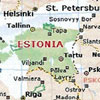Beginnings
 Estonia is a relatively small country situated on the eastern shore of the Baltic Sea in northern Europe. Latvia is its direct neighbour to the south, while the Gulf of Finland separates Estonia from Finland to the north. Directly east lies the vast, sprawling country of Russia. The Estonian language, along with its European counterparts Finnish and Hungarian, belongs to the Finno-Ugric languages. In fact, many Estonians consider themselves mose closely aligned with their Scandinavian neighbour to the north than with other countries in Eastern Europe, particularly Latvia and Lithuania, who, along with Estonia, collectively form Europe's Baltic nations. In the 13th century, Estonia was largely controlled by Teutonic Knights. Known as Livonia, the region adapted Christianity and remained subservient to the Teutonic order until the 16th century when Swedish, Danish, Russian, and Polish forces each claimed portions of Livonia. Later, the northern region of Livonia became known as Estonia. (Eestland). Geographically, Estonia contains over 1,000 lakes, numerous rivers, and various bogs-often indicative of a cold, wet climate.
Estonia is a relatively small country situated on the eastern shore of the Baltic Sea in northern Europe. Latvia is its direct neighbour to the south, while the Gulf of Finland separates Estonia from Finland to the north. Directly east lies the vast, sprawling country of Russia. The Estonian language, along with its European counterparts Finnish and Hungarian, belongs to the Finno-Ugric languages. In fact, many Estonians consider themselves mose closely aligned with their Scandinavian neighbour to the north than with other countries in Eastern Europe, particularly Latvia and Lithuania, who, along with Estonia, collectively form Europe's Baltic nations. In the 13th century, Estonia was largely controlled by Teutonic Knights. Known as Livonia, the region adapted Christianity and remained subservient to the Teutonic order until the 16th century when Swedish, Danish, Russian, and Polish forces each claimed portions of Livonia. Later, the northern region of Livonia became known as Estonia. (Eestland). Geographically, Estonia contains over 1,000 lakes, numerous rivers, and various bogs-often indicative of a cold, wet climate.
Estonian National Symbols
 Estonia's national colours (blue, black and white) date back to the end of 19th century. At that time, the Baltic states, including Estonia, were under Russian Tsarist rule. The colours were chosen in 1881 by a young group of intellectuals belonging to the Estonian Student's Society. Though there are numerous explanations for why they chose these three particular colours it is generally accepted that the colours make reference to a historical metaphor. In this case, blue represents ancient freedom, black symbolizes lost independence while white promises a better future. This era in Estonian history was known as the National Awakening whereby Estonians came to acknowledge their right to self-government and thus sought ways in doing so.
Estonia's national colours (blue, black and white) date back to the end of 19th century. At that time, the Baltic states, including Estonia, were under Russian Tsarist rule. The colours were chosen in 1881 by a young group of intellectuals belonging to the Estonian Student's Society. Though there are numerous explanations for why they chose these three particular colours it is generally accepted that the colours make reference to a historical metaphor. In this case, blue represents ancient freedom, black symbolizes lost independence while white promises a better future. This era in Estonian history was known as the National Awakening whereby Estonians came to acknowledge their right to self-government and thus sought ways in doing so.
The Estonian national anthem, My Native Land, is a choral-like melody arranged by Fredrik Pacius in 1843. The Government of Estonia officially adopted the song in 1920. However, during the decades of Soviet occupation that were to follow, the melody was strictly forbidden and people were sent to Siberian gulags for singing the anthem.
Other national symbols of national significance include the cornflower (national flower), the barnswallow (national bird) and limestone (national rock). For more on Estonia's history and national symbolism please visit www.estonica.org or www.vm.ee/estonia.








